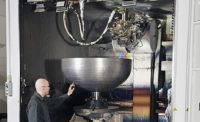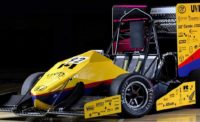Additive manufacturing is no longer just for prototyping. More and more, the technology is being used to make production-ready parts. That’s forcing engineers to begin thinking about joint designs and assembly processes.
Many printed components eventually need to be joined to other parts or subassemblies. And, some parts are just too large to be produced on a single 3D printer.
Whether they are metal or plastic, printed parts can be assembled with all three traditional joining processes: adhesive bonding, mechanical fastening and welding. Typically, most plastic parts are joined with adhesives, while many metal parts are assembled with screws and other types of fasteners.
Additive manufacturing “prints” solid objects from a digital file by depositing one layer of material on top of another, rather than starting with a solid piece of material that is cut and shaped.
The technology allows companies to more easily manufacture complex shapes and structures that have been difficult to make with traditional subtractive manufacturing methods. There’s also less waste, which results in shorter setup times and lower material costs.
Plastic parts are typically made using ultraviolet, infrared or visible light in conjunction with laser or heat energy. Metal parts are produced with laser-based or electron beam-based printers that use metal powders for raw material; the laser or electron beam fuses the powder together.
One of the benefits of additive manufacturing is parts consolidation. Complex, multicomponent parts that previously required assembly can be printed as a single object. That enables engineers to consolidate multiple components or assemblies into one part, eliminating time and assembly costs.
The long-term goal of additive manufacturing is to simplify or reduce the need for assembly. Indeed, a lot of plastic printed parts incorporate snap fits, which eliminates the need for adhesives or fasteners altogether. Typically, snap fits stay within the geometric constraints of mold making and use plastic’s ability to elastically deform and then snap back into shape.
“One of the driving factors behind current additive manufacturing adoption is that the finished part…often eliminates multiple subcomponents or optimizes the design structure of a machined part or group of parts,” says Mike Mowins, president of the Phillips Screw Co.
“A metal or plastic part produced by additive manufacturing can be much lighter in weight and have more complex geometries than a traditionally machined or molded part,” explains Mowins “The result is that you have a single part that will still utilize the same fasteners that the original designed part uses, but will be lighter and have an optimized structural geometry.”
As more manufacturers start to print production-ready metal and plastic parts, sooner or later they’ll need to attach those parts to other components or subassemblies made with traditional manufacturing techniques, such as die-casting, injection molding or machining.
Aerospace Applications
The aerospace industry has been at the forefront of adopting production-ready printed parts for a variety of applications ranging from commercial aircraft cabins to jet engines. Printed parts, such as brackets, are typically joined to aluminum or carbon-fiber composite subassemblies.
For instance, Airbus engineers recently attached a 3D-printed titanium bracket to the aluminum pylon of an A350 XWB jetliner. Other major aerospace manufacturers, such as Boeing, General Electric and Lockheed Martin, are also bullish on the technology.
“We have moved beyond satellites and human-rated spacecraft and applied the technology to missiles, helicopters and airplanes,” says Richard Aston, senior technical fellow for satellite systems at Boeing. “As additive manufacturing becomes a mainstream fabrication method, significant manufacturability improvement and cost reduction can be achieved by approaching design as an integrated mechanical system.
“[However], optimizing additive components will not be possible without sufficient understanding and redesign of the entire system design as a whole,” claims Aston.
“Most aerospace additive manufacturing applications involve metal parts with optimized geometry that is unachievable with traditional machining techniques,” adds Mowins. “The resulting part still performs the same function as the traditional machined part. In fact, it often has the same dimensional envelope as the original part and uses the same fasteners at the joint interfaces as the original part.
“There is a tremendous opportunity to optimize fasteners at the same time that the printed part is optimized,” notes Mowins. “If engineers are adopting the latest additive manufacturing techniques, it makes sense to also adopt the latest high-performance fasteners.
“That is where we are seeing the most activity for our Mortorq spiral drive recessed fasteners and our External Mortorq Super bolts,” Mowins points out. “Aerospace engineers are replacing traditional fasteners with these new, lighter weight parts that provide greater torque control and strength.
“Of course, the majority of additive manufacturing activity is still on the R&D side, where you can quickly produce prototypes of a multi-part assembly with 3D printing and then troubleshoot the design and assembly process with a hands-on model,” says Mowins. “We have done this type of exercise with Rolls-Royce and others where we provided 3D printed parts to mate with their structure redesign and did part assembly optimization in real time.”
As additive manufacturing technology matures, the performance of materials is improving greatly. That’s creating new opportunities for joining printed parts.
“We are seeing more applications in industries where mass customization is beneficial, such as sporting goods or medical devices,” says Ged McGurk, technical customer services manager for 3D printing at Henkel Corp. “[There’s also a lot of activity] in small-volume manufacturing operations, such as aerospace and specialized industrial machinery.”
To address those applications, Henkel has been developing advanced adhesives for a wide range of additive manufacturing technologies, such as specialized filaments for fused deposition modeling (FDM) and powders for fusion-based systems.
“Like any engineering component that needs to be integrated into a final assembly, joining printed parts can be relatively simple if engineers have a good understanding of the capabilities and limitations of the additive manufacturing process,” claims McGurk. “Different printing technologies will produce finished parts with quite different characteristics—even when used to print the same 3D model.
“Dimensional accuracy and stability of the finished part, together with surface finish and the anisotropic nature of some mechanical properties, can all have an influence on the final assembly operation,” explains McGurk. “In these situations, design changes may be required to produce a part that is optimized for the entire manufacturing cycle.”
“Joining printed parts is an active area of research,” adds William Mohr, principal engineer for structural integrity at EWI. “The difficulty can range depending on the material printed and the material that you are attempting to join it to. [However], the most common material choices for both metal and plastic parts are readily weldable to similar materials.”
According to Mohr, dissimilar material joining is more challenging. “In general, the alloys being used in additive manufacturing are weldable, even for dissimilar joining,” he explains. “Areas of concern may be distortion, material properties, degradation and corrosion.
“Distortion comes because parts directly from additive processes often already have high-tension residual surface stresses that will be modified by heating in the joining process,” says Mohr. “Material property degradation [occurs] because the additive material may have microstructure orientation effects from deposition.”
Performance Variables
Printed parts have different properties and performance characteristics that engineers should carefully consider, such as elasticity, porosity and rigidity.
For instance, higher risks for corrosion are usually expected for dissimilar materials. However, additively manufactured materials tend to have local minor variations in chemistry that can exacerbate the corrosion effects.
“Printed parts can differ significantly in terms of their physical and mechanical properties when compared to the same parts manufactured using traditional methods, such as injection molding, even when using the same basic polymer or metal,” explains McGurk. “From a materials science perspective, this shouldn’t be surprising.
“For example, one of the oldest and most common engineering materials, carbon steel, can produce very different properties by changing its internal structure through tempering or annealing,” says McGurk. “The same applies with 3D printing.
“In this case, the layer-by-layer structure produced by the printing process creates properties that can be anisotropic in nature,” McGurk points out. “The layered structure can also lead to gaps or voids in the structure resulting in porosity. This porosity can affect the part’s ability to seal or hold fluids. The layered structure can also be evident in the surface finish or roughness of the printed part.
“Engineers must control the orientation of the part during the printing process, as this will ultimately determine the load-bearing performance of the finished assembly,” warns McGurk. “The variation in surface properties (porosity or roughness profile) may also have an impact on adhesive dispensing or the assembly process.”
“In many cases, you are trying to use additive manufacturing to meet the same design criteria as a cast, forged or machined part, so these differences are minimized,” adds EWI’s Mohr. “Sometimes, you can use the flexibility of the process to reduce the overall weight while still meeting the design intent.”
This can be very beneficial in aerospace applications where weight savings tie directly to fuel costs. The optimization of configuration will increase the average “level of activity” of the material in use, which may be noticeable in the elastic behavior of the material for more sensitive materials.
“Porosity in printed parts has a similar effect on assembly processes to porosity from casting processes, except that printed parts tend to be expected to have a more uniform distribution of porosity than castings,” says Mohr. “The expectation of uniformity helps with designs where a hermetic seal is needed at the joined interface, since a local combination of pores is less likely to be nearly through-wall.
“The type of joining method must be correlated with the design and post-treatment of the printed part,” claims Mohr. “For instance, a socket joint on the printed part will need different amounts of preparation to be welded to an assembly than to be brazed to an assembly, since brazing will need a smoother surface.
“In many cases, the preparation of the side of the printed part toward the base plate, which will be required in any case, provides a location where the special needs of subsequent assembly processes can be addressed,” Mohr points out.
Joining Alternatives
Adhesives, fasteners and welding can all be used to join metal or plastic printed parts
“We still see the same types of joining techniques being used,” says Mowins. “There isn’t much of a difference between a thread-forming fastener used for a traditional molded plastic part vs. a printed plastic part. A fastener with an aggressive thread profile will give you a good joint with either type of part.”
“Joining techniques haven’t changed,” adds Allen Kreemer, principle applications engineer at Stratasys. “Any conventional joining method, such as adhesive bonding or mechanical fastening, will work. For instance, parts printed with FDM technology can be bonded with many types of epoxies and cyanoacrylates. We’ve also tested silicones, urethanes and UV-cured adhesives.
“Two-part epoxies are commonly used to bond FDM parts,” says Kreemer. “After application, bonded sections are fixtured or clamped while the epoxy cures.
“The tensile strength of cyanoacrylate is higher than that of epoxy adhesives,” notes Kreemer. “However, its resistance to high temperatures, chemicals and solvents is poor. Therefore, bonding with cyanoacrylate may diminish the performance of FDM parts. So, it is recommended for concept models and form-and-fit prototypes rather than functional prototypes or manufactured parts.”
Ultrasonic welding is another joining alternative, especially for parts that are printed with thermoplastic materials. “When higher strength is needed, ultrasonic welding may be used in combination with other methods,” says Kreemer. “This approach is especially useful for bulky or awkward assemblies.”
Mechanical fasteners are another effective alternative. “There are a large number of mechanical fastening approaches and hardware options that can be used when joining FDM parts,” claims Kreemer. “One unique approach to mechanically join sections is to insert fastening hardware in the part during its build process. When it emerges from the [printer], the fasteners are integrated within the part.”




